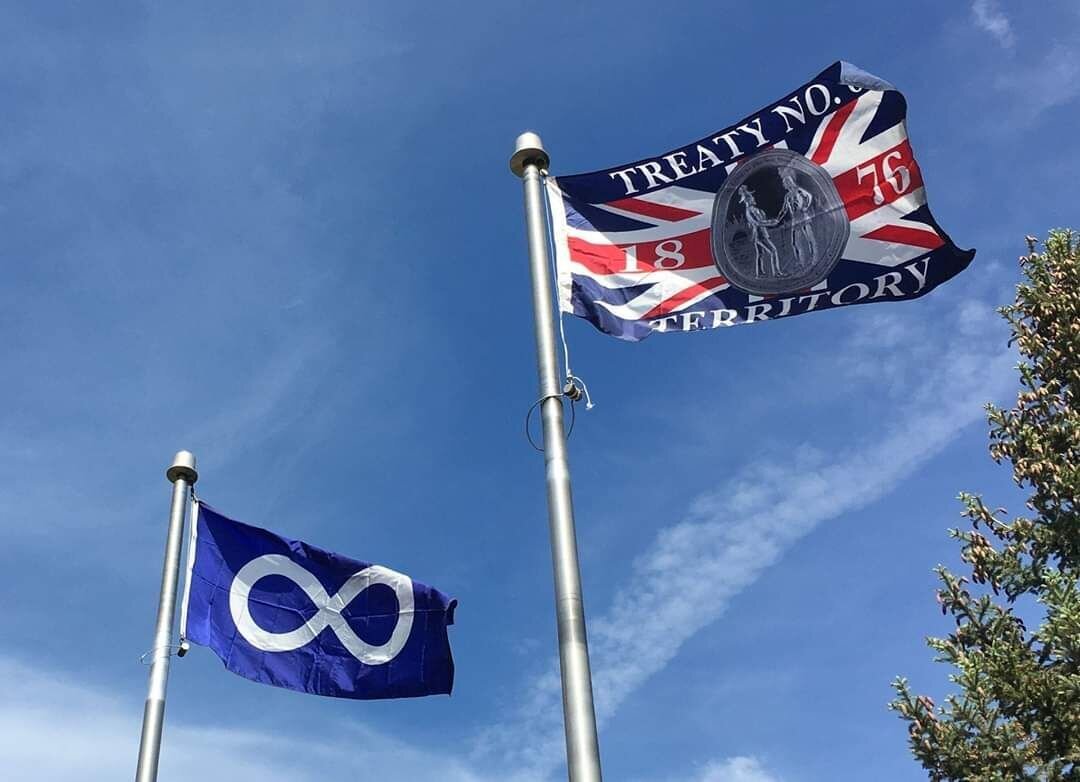Hey there You have done a fantastic job I will certainly digg it and personally recommend to my friends Im…
Written By Wyatt Claypool, Posted on January 29, 2020

January 27th the City of Saskatoon’s council unanimously approved the displaying of Treaty 6 Métis Nation flags at city-run facilities in a display of respect for the traditional owners of the land.
This is a trend that has also included the town of Peace River displaying Treaty 8 Métis flags out of respect for the traditional owners of the land by the Métis Nation on which Peace River is built.
This will include the city hall, the council chambers, courthouse, and other city-owned and operated facilities.
This was done based on recommendations by Canada’s Truth and Reconciliation Commission which had recommended 93 different potential actions to take on reconciliation.
The displaying of flags satisfies both recommendations 44, and 43, which are meant to be able to not only display the Métis Nation’s flag but do it in order to strengthen relations between Canadian and Indigenous / Métis people.
In reality, despite the recommendations of the Truth and Reconciliation Commission, in this political era it seems fitting that the Métis and western Canadians come together while frustrations having to do with the Liberal federal government have skyrocketed in the past few years.
Those in support of the Wexit movement and political party can easily identify themselves with the political character of the Métis Nation.
Just recently the Métis National Council had to suspend the Métis Nation of Ontario for having started to recognize people and communities as being Métis with no respect to cultural and historical evidence needed for official recognition. Yet another example of the Métis having to police eastern entitlement in playing fast and loose with the rules, even within their own Métis coalition.
It should be remembered that Manitoba became a province due to the Métis people’s resistance to having their own land illegally given to the Hudson’s Bay Company in a land deal swapping Rupert’s land for Money and ownership of “the Fertile Belt” in the southern Canadian west which illegitimately included Métis owned land.
Other things leaders like Louis Riel did maybe a controversial character, but the original Red River Rebellion (sometimes called the “Red River Resistance”) in 1869-70 was simply a legitimate pushback against the eastern federal governments’ heavy-handed entitlement to control over western Canadian land, whether occupied or not.
Western Canadians shouldn’t see the displaying of the Métis treaty 6 flags as something at all foreign to them, despite not being directly related to the Métis, the culture of the western provinces and their resistance to the federal government meddling is closely connected to the Métis people.
All western provinces should proudly fly the flags of the various treaties, as it grows a more friendly relationship between indigenous and non-indigenous westerners, but it is also in the spirit of western autonomy and rejection of top-down eastern federal rule.
For the east treaty, flag displays can be for social justice, in the west, it will be for mutual respect for history and cultural similarities.
Wyatt is a student at Mount Royal University, where he is the president of its Campus Conservative club. In his writing, he focuses on covering provincial and federal politics, firearms regulation, and the energy sector. Wyatt has also previously written for The Post Millennial.
Metis is a Canadian term referring to Indian/French.
In what is today Western Canada the term Mixed Bloods referred to Indian/Scottish and Indian/British or English. It has become much more politically advantageous to use the term Metis, at least since the Canadian take over, so that term now includes the Mixed Bloods who will have no French DNA.
Which is why I would agree that Western Canadians shouldn’t see the displaying of the Métis treaty 6 flags as foreign. They are as Western Canadian as any other group.
BUT flag displays for social justice, or mutual respect of history and cultural similarities should not be confused with acceptance of past racial prejudices.
Aboriginals and Metis have special racial status in Canada. In Canada a persons race (First Nation or not) determines their roles and responsibilities. Race classification (treaty or not) decides how much tax a citizen pays, where they can live, if they can own the house they live in, which health insurance program they use, how they are treated by the courts, even which school or treatment program they can attend.
Many Western Canadian supporters of First Nations and Metis fully support their self determination goals and want to work to help achieve those but not if it means special status for some citizens based on race.
At the same time special racial status is a Canadian reality that Western Canadians want to address. Canadian laws, polices and practices based on the race of a citizen has resulted in an ongoing death and misery that cannot be ignored.
Those wanting to end the misery and death created by Canada’s ongoing racial laws, policies and practices, are seeing hope in Western Independence and Separation.
Western Canadians harmed by Canada include many racial groups but some, like the Metis, have paid a very high price and that is recognized more so by Western Canadians, than any in Canada (which is effectively just Ontario and Quebec)..
This is absolutely spot-on. Western Canada’s original flag could be argued to be the Metis (‘figure-eight’) flag. Our founding fathers are Louis Riel, Gabriel Dumont and others who led the two Resistances. I am of European blood, but as a Western Canadian I identify closely with the independent spirit of the Metis, who set up the Manitoba Provisional Government in direct opposition to Canadian Laurentian elites treating their land like a colony to be divided and exploited… and under Louis Riel’s adept leadership successfully negotiated Manitoba’s status as a homeland for the Metis people. Of course, the Feds broke their promise, like they always to to the West.